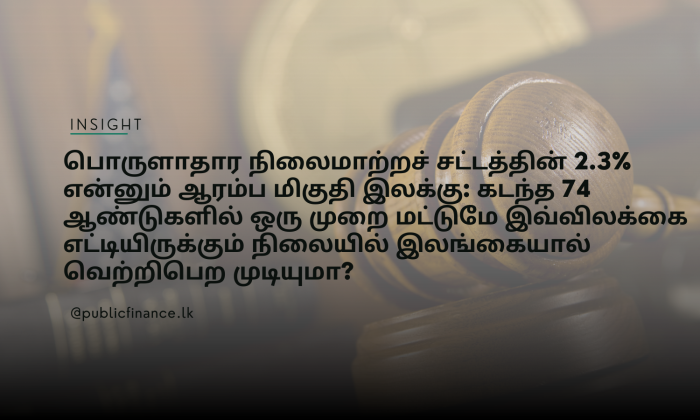


சமீபத்தில் இயற்றப்பட்ட பொருளாதார நிலைமாற்றச் சட்டம் (ETA), வரும் ஆண்டுகளில் அடைய வேண்டிய அரசாங்கத்தின் நிதி முகாமைத்துவம் தொடர்பான ஐந்து இலக்குகளை நிர்ணயித்துள்ளது. கீழே குறிப்பிடப்பட்டுள்ள இந்த இலக்குகள் நிதி ஒழுக்கத்தை உறுதிசெய்வதையும் பொருளாதார நெருக்கடி மீண்டும் ஏற்படுவதைத் தடுப்பதையும் நோக்கமாகக் கொண்டுள்ளன.
ஆரம்ப மிகுதிக்கான இலக்கு: 2032 ஆம் ஆண்டு வரை ஆரம்ப மிகுதியை மொத்த உள்நாட்டு உற்பத்தியில் 2.3% ஆகவும், 2032 ஆம் ஆண்டுக்குப் பின்னர் மொத்த உள்நாட்டு உற்பத்தியில் 2% ஆகவும் பேண வேண்டும் என ETA இன் பிரிவு 4(எ) குறிப்பிடுகிறது. (ஆரம்ப மிகுதி என்பது அரசாங்கத்தின் வருமானத்துக்கும் அதன் வட்டி அல்லாத செலவினங்களுக்கும் இடையே உள்ள வித்தியாசம் ஆகும்).
அரசாங்க வருமான இலக்கு: 2027 ஆம் ஆண்டிற்கு அப்பால் அரசாங்க வருமானம் மொத்த உள்நாட்டு உற்பத்தியில் (GDP) குறைந்தபட்சம் 15% ஐ எட்ட வேண்டும் என்று பிரிவு 4(ஏ) கூறுகிறது.
அரச படுகடன் மறுசீரமைப்பு இலக்குகள்: 2032 ஆம் ஆண்டிலும் அதற்குப் பின்னரும் மொத்த உள்நாட்டு உற்பத்தியில் அரச படுகடன் விகிதம் 95%க்கும் குறைவாக இருக்க வேண்டும் எனப் பிரிவு 3(1)(அ)(i), (ii), மற்றும் (iii) ஆகியவை குறிப்பிடுகின்றன. 2032 ஆம் ஆண்டில் மொத்த உள்நாட்டு உற்பத்தியில் மத்திய அரசாங்கத்தின் ஆண்டு மொத்த நிதியிடுதல் தேவைகளின் விகிதம் 13%க்கும் குறைவாக இருக்க வேண்டும். 2027 ஆம் ஆண்டிலும் அதற்குப் பின்னரும் மொத்த உள்நாட்டு உற்பத்தியில் மத்திய அரசாங்கத்தின் ஆண்டு கடன் சேவையானது வெளிநாட்டு நாணயத்தில் 4.5%க்கும் குறைவாக இருக்க வேண்டும்.
2025 ஆம் ஆண்டு முதல் பொருளாதாரக் கொள்கைக்குப் பொறுப்பான அமைச்சர் இந்த இலக்குகளைச் செயற்படுத்துவதற்கான கொள்கை கட்டமைப்பையும் உத்திகளையும் முன்வைக்க வேண்டும். அத்துடன், ஒவ்வொரு ஆண்டும் மார்ச் 31 ஆம் திகதிக்குள் குறித்த இலக்குகளை அடைவதற்காக எடுக்கப்படும் நடவடிக்கைகள் குறித்த வருடாந்த அறிக்கை பாராளுமன்றத்தில் சமர்ப்பிக்கப்பட வேண்டும். இலக்குகள் அடையப்படாவிட்டால், அதற்கான தீர்வு நடவடிக்கைகள் மற்றும் இலக்குகளை அடைவதற்கான காலக்கெடு ஆகியவை அறிக்கையில் குறிப்பிடப்பட வேண்டும்.
எவ்வாறாயினும், 2-2.3% என்னும் ஆரம்ப மிகுதிக்கான இலக்கு இலங்கையின் உண்மையான பதிவுகளில் முன்னெப்போதும் இல்லாத உயர் மட்டத்தில் நிர்ணயிக்கப்பட்டுள்ளது. கடந்த 74 ஆண்டுகளில் 1955 ஆம் ஆண்டில் ஆரம்ப மிகுதி மொத்த உள்நாட்டு உற்பத்தியில் 2.8% ஐ எட்டியபோது இந்த இலக்கு ஒருமுறை எட்டப்பட்டது. 1954, 1955, 1992, 2017, 2018 மற்றும் மிகச் சமீபத்தில் 2023 ஆம் ஆண்டில் என அரசாங்கம் கடந்த காலங்களில் ஆறு ஆண்டுகள் மட்டுமே நேர்மறை மீதியை எட்டியுள்ளது.
கடந்த காலங்களில் 2003 ஆம் ஆண்டின் 3 ஆம் இல.அரசிறை முகாமைத்துவ (பொறுப்பு) சட்டத்தில் (FMRA), இதே போன்ற வரம்பு இருந்தது. இது 2006 ஆம் ஆண்டு முதல் மொத்த உள்நாட்டு உற்பத்தியில் வரவு செலவுத்திட்டப் பற்றாக்குறை 5% ஐ விட அதிகரிப்பதைத் தடை செய்தது. ஆனாலும் இந்த வரம்பை எட்டுவதற்கு அனைத்து ஆண்டுகளிலும் அரசாங்கம் தவறிவிட்டது. FMRA உடன் இணங்கத் தவறியமை பொறுப்பற்ற தன்மையைக் காட்டுகிறது என்பது பற்றிய எங்கள் வலைத்தள பதிவைப் பார்வையிடவும்.
எனவே, கடந்த காலத்தில் அரிதாகவே அடையப்பட்ட அத்தகைய இலக்கை அறிமுகப்படுத்துவது நிதி ஒழுக்கத்தை மீட்டெடுப்பதற்கான இந்த இலக்கை அரசாங்கத்தால் அடைய முடியுமா அல்லது FMRA வரம்பைப் போலவே மீறப்படும் மற்றொரு வரம்பாக இருக்குமா என்ற கேள்வியை எழுப்புகிறது.
மூலம்
ஆகஸ்ட் 2024 இல் வெளியிடப்பட்ட அதிவிசேட வர்த்தமானி இல. 45/2024, http://www.documents.gov.lk/files/act/2024/8/45-2024_E.pdf [இறுதியாக அணுகியது: 16 ஆகஸ்ட் 2024]
இலங்கை மத்திய வங்கி, "சிறப்பு புள்ளிவிபரப் பின்னிணைப்பு," ஆண்டறிக்கை 2023, https://www.cbsl.gov.lk/sites/default/files/cbslweb_documents/publications/aer/2023/en/19_Special_Statistical_Appendix.pdf [இறுதியாக அணுகியது: 16 ஆகஸ்ட் 2024]